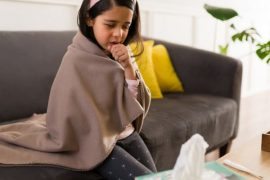Зміст
Whether you know that there are more than 200 various viruses, which can cause flu in children? The school, games with other children in the park or strong temperature differences are only some risks of infection to which children are exposed in everyday life. Strengthening of the immune system at this age is important that viruses out of and consequences in order to avoid unhealthy.
No flu at children is a cold synonym, methods of fight against them not the same.
Do you know how flu lasts long?
Learn how to define symptoms of common flu and what means to cure of flu for children!
What is flu and when cold
Flu is an infectious disease, with character infectious, which influences airways. Its weight varies depending on age group. Actually, flu symptoms at children, as a rule, are more expressed and accompanied by big risk, than at adult age.
In particular, it is necessary to show care at flu at one-year-old children because at the time of the high level of infection the number of hospitalization small of them is so high, as well as adults with risk factors.
Quite another matter – cold. Though these two symptoms have some general symptoms, the risk of complications for children at flu is much higher. Therefore, they have to be able to distinguish!
Differences between cold and flu
Differences between flu and cold are not absolute. Both have general symptoms, such as snivels, a general malaise because of which the child becomes less active or coughs.
To learn how to define it, you should look at the following:
- Emergence of symptoms. If at cold, the first signs appear gradually and several days last, then at flu they appear suddenly and can last from one to 2 weeks.
- Fever. If the thermometer shows several tenths, perhaps, it is cold. However, if at your child the moderate or high temperature (more than 38 °C), is an obvious symptom of flu.
- Your child sneezes. If so, most likely, it is cold.
- One more difference between flu and cold is that children at first feel fatigue that seldom happens at cold.
- Muscular pains. They are very widespread from flu, but not for cold.
Symptoms and diagnosis of flu
In the majority of the general symptoms of flu at children are:
- Fever, as a rule, is above 38 °C.
- The fever and a tremor are obese.
- Headache and muscle pains.
- Sore throat and dry and rough cough.
- Fatigue and some irritability.
- Sometimes some children have a vomiting and diarrhea.
Flu stages at children
The incubation period of flu is from 1 to 4 days, depending on the child, and then by means of emergence of symptoms. Besides, the patient with flu has ability to infect of 1 day before emergence of symptoms up to 5 days after the beginning of them.
It was shown that children of school age are the main way of transfer of flu in a family kernel. They have even higher virus loading and longer, than at adults!
Therefore, it is important that in winter and spring months you knew about possible symptoms at your child.
At a flu stage at children are:
- Emergence of the easy symptoms testifying to the beginning of the period of flu, such as irritation and dryness in a throat.
- General malaise and fever. At first, it will be several tenth, and then will begin to grow. Muscular pains and over fatigue can follow it.
- If in several days the lower airways are affected, for the child the dry cough and slime will develop.
- Gradually, symptoms will decrease. At first, the heat and pain will disappear, but slime will remain. At this final stage, the child can lose sense of taste and a smell.
How does flu last long?
Flu usually lasts from five to 10 days, since the moment when the first symptoms appear, while the person restores the usual state of health.
Treatment of flu
Drugs
- It is not recommended giving to the child any drugs, except prescription. Combine rest with the correct diet to facilitate symptoms.
- Use of antibiotics should be limited only to a bacterial infection. In addition, it is not recommended to give aspirin to children.
- Antiviral self-treatment, as a rule, does not specify as they can cause collateral reactions and, as a rule, do not come into force for flu at children. Actually, it is recommended only to children with risk of complications, heavy symptoms of flu or when they are in contact with family members or people from group of high risk.
- If your child has a high temperature, and it keeps several days, try to reduce it. Look at these means for decrease in temperature at children!
Feeding
- The best diet to fight against flu at children is a diet with a large amount of liquid to avoid dehydration.
- Sometimes because of a disease and heat at the children who got the flu, the appetite is lost. It is important that they well ate, but they cannot force to be eaten! Taste hot broths and soups, which are pleasant to them.
- At flu, it is desirable to keep to a diet from white products. At preparation, use such methods as boiling, frying on a grill, roasting to achieve more smooth texture and to facilitate digestion of your child. Avoid too fat, sharp and semifinished products!
Heat baths
- One more flu medicine for children – heat baths. The contact with water will bring to the child a sense of relief, neutralizing discomfort. Even if at your child the high temperature, a heat bath (near 34ºC) will be useful!
- Do not forget to dry the child after a bathtub. For this purpose, during drying do not subject him to low temperature impact. It is important to avoid sharp temperature drops!
When to go to the doctor?
Address to the emergency room or visit the pediatrician of your child in the following cases:
- Often tears
- He refuses to drink liquids and does not eat.
- Has trouble breathing.
- Fever is above 38.5 °C.
- After 48 hours of improvement, it is not observed.
- Tears disappeared when he cries.
- If your child does not wake up or does not react to irritants.
How to prevent flu at children
The best way to prevent flu for children is to do them annual vaccination. At some schools for simplification of this process, vaccination campaigns are conducted. Besides, to make it with schoolmates always easier!
You have to accustom the child to keep some healthy habits in everyday life. Washing of hands before food – a good way of protection against viruses. Teach him to do it at least 30 seconds, and it is good to pound all parts of hands, including nails and between fingers.
On the other hand, it strengthens your immune system at the expense of the diet rich with fruit and vegetables. Vitamin C stimulates protective forces to help to protect all types of viruses of flu and bacteria.
Products with the highest content of vitamins are a citrus, such as orange, tangerine or grapefruit. You can also taste strawberry, a kiwi or vegetables, for example, paprika.








